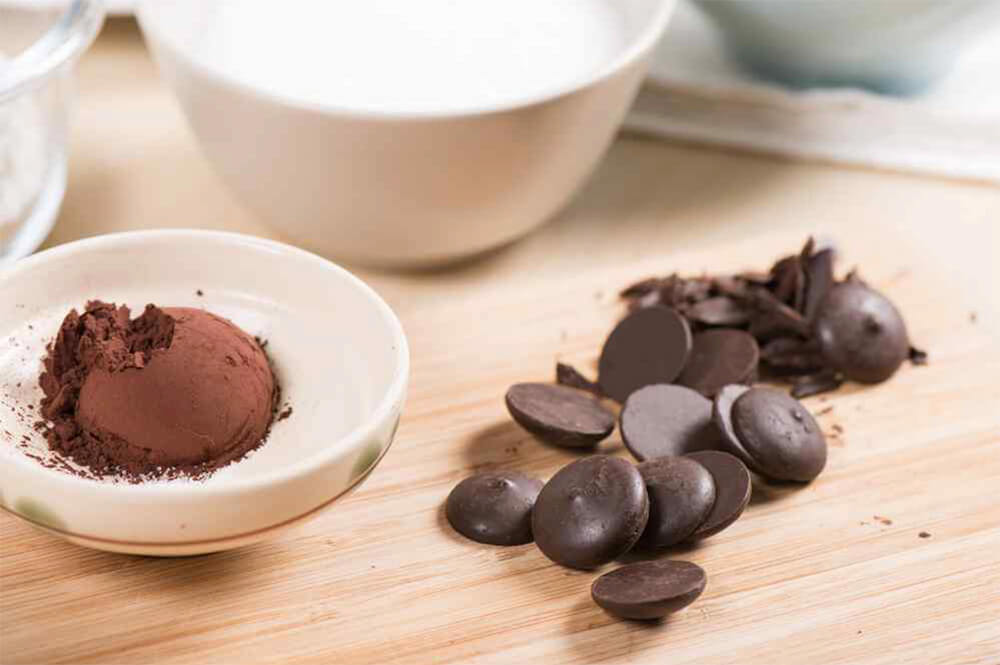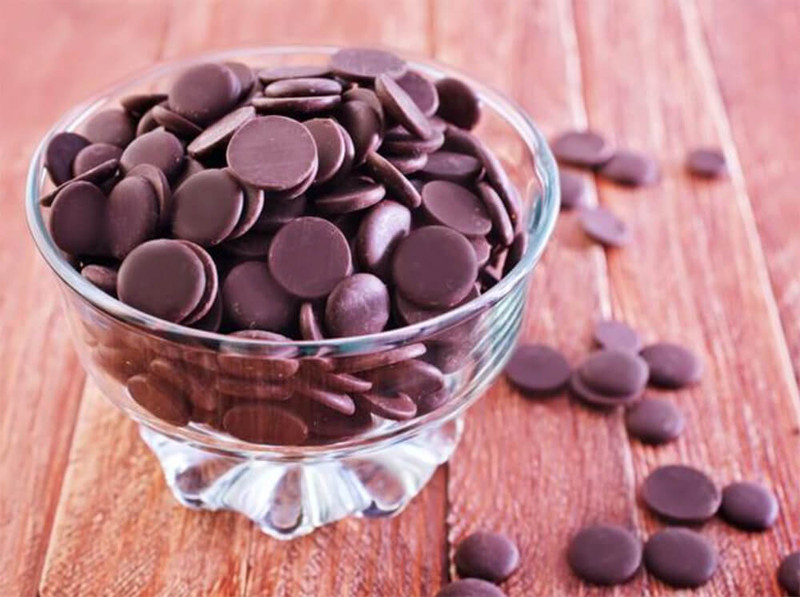If you love baking chocolate and confections, you’ve likely come across the term couverture chocolate. And since you’re reading this, you’re here for an answer to the question that probably sprung to your mind - What is couverture chocolate and how does it differ from regular chocolate?
In essence, the term couverture chocolate refers to high-quality chocolate widely used in the confectionery industry. What differentiates couverture chocolate from standard dark chocolate is the higher percentage of cocoa butter. To understand what is couverture, it's essential to note that in the US and Europe, couverture chocolate must contain at least 35 percent cocoa solids and 31 percent cocoa butter, with some couverture chocolates containing as much as 39 percent cocoa butter.
That higher percentage of cocoa butter makes couverture chocolate more fluid when melte. with a richer flavor due to cacao grind time. These two differences make couverture chocolate a preferred choice among confectionery professionals, who find it perfect for tempering, using it to make such confections as truffles, bonbons, or pastries.
And if you’d like to experiment with couverture chocolate yourself, this post will answer all the questions you might have regarding the matter. Below, we’ll cover a more detailed explanation of the couverture itself, how to use it, and where to buy it. We’ll also answer some of the frequently asked questions regarding couverture chocolate.
Ingredients and Benefits of Couverture Chocolate
As covered, the main distinction between couverture and regular chocolate is the percentage of cocoa butter. For chocolate to be considered couverture, it must contain a minimum of 31 percent cocoa butter, compared to 15 percent for an average bar of milk chocolate and 18 percent for dark chocolate. However, when it comes to ingredients, couverture chocolate shouldn’t be different from regular high-quality chocolate.
Typically, couverture chocolate consists of:
- Cocoa solids. These are the core components of any type of chocolate. They're derived from the cocoa bean, fermented, dried, and roasted. As mentioned, couverture chocolate should contain at least 35 percent cocoa solids.
- Cocoa butter. It comes from pressed cocoa beans. In general, the more cocoa butter in the couverture, the more fluid it becomes when melted. Couverture chocolate should contain between 31 and 39 percent cocoa butter.
- Sugar. In general, cocoa butter and solids have a bitter taste. To help couverture balance flavors, manufacturers sweeten it with sugar.
- Emulsifier (lecithin). Lecithin’s purpose is to bind cocoa solids with milk and sugar so that they stick to cocoa butter. It’s usually derived from soy or sunflower, and it helps improve the couverture’s consistency and its shelf life.
- Milk powder. The key ingredient for milk couverture chocolate (not used in dark couverture).
Of course, these ingredients may slightly differ depending on the manufacturer, but these are pretty much the standard for couverture chocolates.
Now, as for the benefits couverture chocolate provides, we can include its rich flavor and how easy it is to work with. In general, couverture is considered higher-quality chocolate, which is why it’s so popular among professional confectioners.

How to Use Couverture Chocolate?
Couverture is the perfect chocolate for dipping and tempering. All thanks to the higher percentage of cocoa butter, which allows couverture chocolate to melt quicker, making it much easier and more efficient to work with when preparing confections. In fact, the name couverture derives from the French word ‘to cover.’ Long story short, couverture chocolate is a perfect choice when dipping or garnishing your chocolate confections.
Dipping your creations in couverture will provide them with a deeper chocolate flavor and a firmer ‘snap’ when bitten into the candy. It will also improve their looks, adding a mesmerizing shine. However, it’s important to note that you should temper the couverture after melting it. Otherwise, it might develop a chocolate bloom and matte appearance. Tempering chocolate is the process of raising and lowering its temperature to alter the chocolate’s crystal formation.
There’s also a question regarding using couverture chocolate for cooking and baking. When it comes to that, the answer isn’t entirely straightforward. Generally speaking, you can use couverture when baking, although it can alter your bake, behaving differently in recipes involving melted chocolate, such as brownies or chocolate cakes. That’s because couverture contains a higher percentage of cocoa butter, meaning it’s relatively high in fat.
If you want to bake something that calls for melted chocolate to be added to a batter, try dark chocolate couverture as it works perfectly melted as an ingredient, as well as, to dip your confections enhancing their taste and looks. You can use it to make clusters or barks, cover truffles, or make chocolate bars.
Where to Buy High-Quality Couverture Chocolate?
It goes without saying that you should always use top-quality couverture chocolate if you want the best tasting dessert. The question here is, where to find the best couverture? The answer is simple - Santa Barbara Chocolate. Our couverture chocolate is just the thing you need to take your confectionery experience to an entirely new level.
The Santa Barbara couverture chocolate is made of the highest-quality Criollo cacao - the world's rarest and most tasteful cacao beans. On top of that, it’s 100 percent vegan, has no added soy or vanilla, and consists of 66 percent of cacao solids. All this makes our couverture chocolate one of the best in the industry.
If you seek couverture chocolate that’s fully organic and has a superior taste, Santa Barbara couverture is a perfect choice. It will work brilliantly when preparing chocolate cakes, pastries, chocolate fondue, and more!
Frequently Asked Questions
Let’s take a look at some of the frequently asked questions regarding couverture chocolate:
Is it okay to eat couverture chocolate as it is?
Yes, you can eat couverture chocolate as it is. In fact, it’s quite an experience as couverture comes with a deeper and richer chocolate taste compared to other types of chocolate. What’s more, because it’s high in cocoa butter, it melts fabulously in the mouth.
What are the differences between couverture chocolate and regular chocolate?
Couverture chocolate consists of a higher percentage of cocoa butter compared to regular chocolate. For chocolate to be considered couverture, it has to include at least 31 percent cocoa butter, but this level can go as high as 39 percent. This means that couverture chocolate melts quicker and is easier to work with when preparing confections.
How can you tell if the couverture is good quality?
Top-quality couverture chocolate should have a rich chocolate flavor and melt quicker when compared to standard chocolate. You should also look at its ingredients and see what type of cacao beans were used to make it, as well as whether it contains any vegetable fats. If yes, then it means couverture is of lower quality.
How to store couverture chocolate?
To ensure your couverture chocolate retains its flavor, you should follow several rules to store it properly. These include:
- Don’t keep couverture chocolate in the fridge
- Store it in a cool and dry place
- Keep it in an airtight container
- Don’t keep it lying around in the light
Sticking to the above rules should ensure your couverture chocolate stays unchanged for months, keeping its structure and unique flavor.
Can I use couverture chocolate for baking?
Couverture chocolate is perfect for dipping, tempering, and enrobing fruits or truffles. However, when it comes to baking, its high level of cocoa butter can alter your bake. In general, when working with a recipe that requires melted chocolate, a better idea might be to use a regular bar of chocolate and save couverture for dipping.
Final Word on Couverture Chocolate
Couverture chocolate is not the ordinary chocolate you see on supermarket shelves. It’s top-quality chocolate used by renowned confectionery professionals, who value couverture for its deep and rich flavor. What’s more, couverture consists of a higher level of cocoa butter, making it easier to work with and faster to melt. However, it’s important to note that couverture is mostly used for dipping and tempering. For baking purposes, it might be better to stick to standard chocolate.
Other than that, couverture chocolate is perfect for chocolate enthusiasts who want to experience a richer taste.

